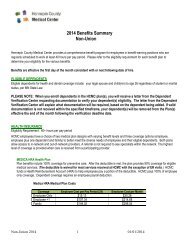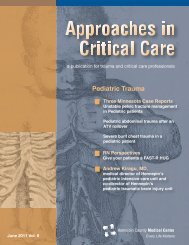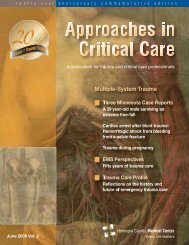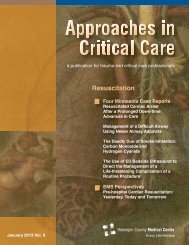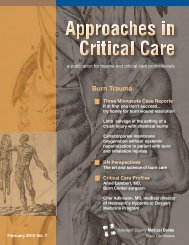Ischemic Stroke - Hennepin County Medical Center
Ischemic Stroke - Hennepin County Medical Center
Ischemic Stroke - Hennepin County Medical Center
Create successful ePaper yourself
Turn your PDF publications into a flip-book with our unique Google optimized e-Paper software.
News Notes<br />
News Notes<br />
Analysis reveals most<br />
common barriers to rapid<br />
stroke treatment<br />
The overwhelming majority of ischemic<br />
stroke patients don’t receive the lifesaving,<br />
disability-preventing drug,<br />
tPA, says a report published in the<br />
August 2008 issue of <strong>Stroke</strong>: Journal<br />
of the American Heart Association.<br />
The analysis, which included data on<br />
more than 15,000 patients at hospitals<br />
enrolled in the North Carolina<br />
<strong>Stroke</strong> Registry, found some of the<br />
most common reasons patients don’t<br />
receive tPA are:<br />
<br />
<br />
Patients don’t seek care in time.<br />
TPA and other clot-busting drugs<br />
must be given within three hours<br />
of symptom onset and a CT scan<br />
must be performed in advance of<br />
drug administration. More than<br />
75% of stroke patients do not<br />
seek care within two hours of<br />
symptom onset, which would<br />
provide hospitals with sufficient<br />
time to conduct the exam and<br />
testing necessary before tPA may<br />
be administered.<br />
Hospitals do not provide rapid<br />
CT scans. Guidelines from the<br />
National Institute of Neurological<br />
Disorders and <strong>Stroke</strong> (NINDS)<br />
recommend CT scans be provided<br />
within 25 minutes of arrival of<br />
potential stroke patients but hospitals<br />
typically do not meet this<br />
goal. Of the 25% of stroke<br />
patients who arrive at the hospital<br />
within two hours after symptom<br />
onset, less than 1/4 receive a CT<br />
scan within 25 minutes.<br />
Other findings of the analysis included:<br />
Patients arriving via ambulance<br />
were more likely to receive a<br />
timely CT scan than those who<br />
self-transported. Approximate half<br />
of patients used emergency medical<br />
services to transport.<br />
Patients receiving care at primary<br />
stroke centers (a designation<br />
created by the Joint<br />
Commission) were more likely to<br />
receive a timely CT scan.<br />
The achievement of timely CT<br />
scans was not related to factors<br />
such as health insurance status,<br />
race, time of day, and<br />
weekend vs. weekday arrival.<br />
However, women were found to<br />
be less likely to receive timely CT<br />
scans than men.<br />
_____________________________<br />
Team releases data on stroke<br />
treatment times at 2008<br />
International <strong>Stroke</strong> Conference<br />
The stroke team at <strong>Hennepin</strong> <strong>County</strong><br />
<strong>Medical</strong> <strong>Center</strong> has released data<br />
showing that after their dedicated<br />
stroke team was implemented,<br />
ischemic stroke patients were treated<br />
more frequently with IV tPA and<br />
received IV tPA more quickly.<br />
The data were presented by Gustavo<br />
Rodriguez, MD, at the 2008<br />
International <strong>Stroke</strong> Conference in<br />
New Orleans, LA. According to the<br />
presentation, during 2005 the following<br />
interventions were put into place:<br />
Approaches in Critical Care | December 2008 | 19





